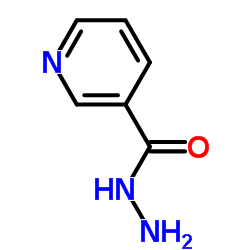Evidence for isoniazid-dependent free radical generation catalyzed by Mycobacterium tuberculosis KatG and the isoniazid-resistant mutant KatG(S315T).
N L Wengenack, F Rusnak
文献索引:Biochemistry 40(30) , 8990-6, (2001)
全文:HTML全文
摘要
The antitubercular agent isoniazid can be activated by Mycobacterium tuberculosis KatG using either a peroxidase compound I/II or a superoxide-dependent oxyferrous pathway. The identity of activated isoniazid is unknown, but it has been suggested that it may be a free radical intermediate. In this work, EPR spin trapping experiments detected isoniazid-derived radicals generated during KatG-mediated oxidation via the peroxidase compound I/II pathway. On the basis of hyperfine splitting patterns and oxygen dependence, these radicals were identified as the acyl, acyl peroxo, and pyridyl radicals of isoniazid. Isoniazid-resistant KatG(S315T) produced the same radicals found with KatG, while the less potent antitubercular agent nicotinic acid hydrazide produced the corresponding nicotinyl radicals. The time course of radical production was similar for KatG and KatG(S315T), while a lower steady-state level of radicals was produced from nicotinic acid hydrazide. These results support an earlier finding that the peroxidase pathway does not correlate with isoniazid resistance conferred by KatG(S315T). Trace amounts of radicals were detected via the superoxide-dependent pathway. The low level of isoniazid-derived radicals found in the superoxide-dependent pathway may be due to scavenging by superoxide.
相关化合物
| 结构式 | 名称/CAS号 | 分子式 | 全部文献 |
|---|---|---|---|
 |
烟酸酰肼
CAS:553-53-7 |
C6H7N3O |
|
Controlled release studies of antimalarial 1, 3, 5-trisubsti...
2015-01-01 [Colloids Surf. B Biointerfaces 125 , 151-9, (2015)] |
|
Chemokine CCL17 induced by hypoxia promotes the proliferatio...
2015-01-01 [Am. J. Cancer Res. 5 , 3072-84, (2015)] |
|
Double-level "orthogonal" dynamic combinatorial libraries on...
2001-02-13 [Proc. Natl. Acad. Sci. U. S. A. 98(4) , 1347-52, (2001)] |
|
Peroxidase-mediated oxidation of isoniazid.
1985-03-01 [Antimicrob. Agents Chemother. 27(3) , 399-403, (1985)] |
|
T cell-mediated induction of thymic stromal lymphopoietin in...
2014-07-01 [Clin. Exp. Allergy 44(7) , 953-64, (2014)] |